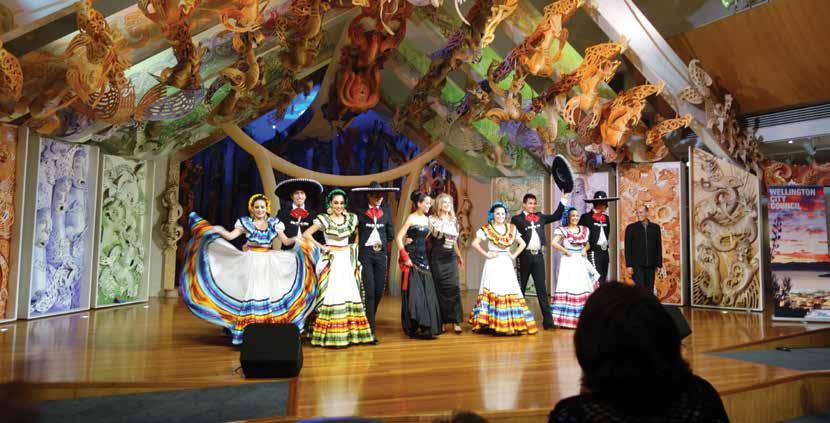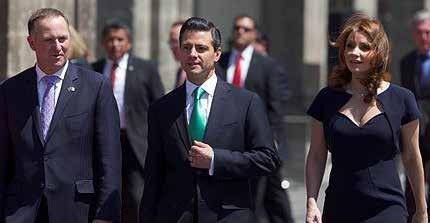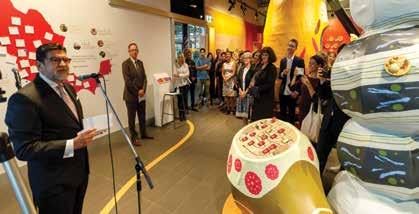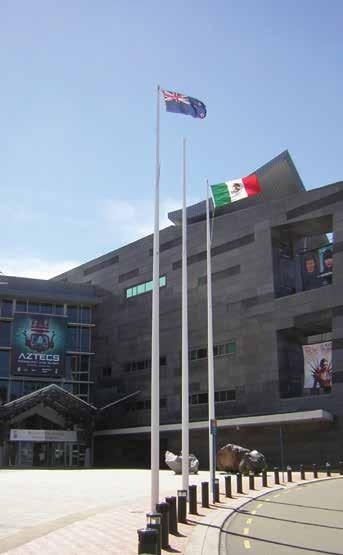
15 minute read
Cultural diplomacy between New Zealand and Latin America
Lee Davidson uses a Mexican case study of museum and state collaboration in international exhibitions to reflect on New Zealand–Latin America cultural relations.
Cultural relations between New Zealand and Latin America include a wide range of activities from state-supported cultural diplomacy to non-state actors such as museums pursuing an international agenda to transnational networks of individual artists. The agreement to exchange two landmark exhibitions, Te Papa’s ‘E Tū Ake: Standing Strong’ and the Mexican Instituto Nacional de Antropología e Historia’s ‘Aztecs: Conquest and Glory’, was a landmark event. It not only provides a good example of museum and state co-operation in pursuit of intersecting objectives but also raises questions about how the value of cultural relations might be better evaluated and appreciated in order to ensure its future potential is realised.
In the early 1970s, ‘Portrait of Mexico’, one of the largest exhibitions ever seen in New Zealand toured the country. It featured sculpture, painting, ceramics, pottery, folk art and religious art, spanning 35 centuries from pre-Columbian to contemporary works and was accompanied by a team of Mexican experts who gave lectures and guided tours.1
International exhibitions are a common form of cultural diplomacy. Some are fully state funded to achieve foreign policy goals, while others involve non-state actors, such as museums, pursuing their own mission, market and diplomatic agendas, that are often aligned with national foreign policy agendas. Organised by the Mexican Secretaría de Cultura and the Queen Elizabeth II Arts Council of New Zealand, ‘Portrait of Mexico’ was a seminal event in terms of cultural relations between New Zealand and Latin America. It took place at the same time as formal diplomatic relations between New Zealand and Mexico began in 1973. The 1970s also saw the establishment of the first dedicated Cultural Exchange Programme within New Zealand’s Ministry of Foreign Affairs.2
Dr Lee Davidson is an associate professor in museum and heritage studies at Te Herenga Waka Victoria University of Wellington. Her areas of expertise include visitor studies, intercultural museum practice, cultural diplomacy and international exhibitions.
Four decades later, a close relationship between Mexico’s Instituto Nacional de Antropología e Historia (INAH) and the Museum of New Zealand Te Papa Tongarewa resulted in the exchange of two landmark exhibitions: ‘E Tū Ake: Standing Strong’ and ‘Aztecs: Conquest and Glory’. This first ever formal exhibition exchange between New Zealand and Mexico was the subject of an in-depth investigation of international exhibitions, cultural diplomacy and intercultural dialogue.³ This article gives an outline of the diplomatic work of this exchange as an example of museum and state co-operation in pursuit of intersecting objectives on the international stage. The case study also gives insight into the evolution of cultural exchanges and diplomacy with Latin America and considers its potential futures.
Brief history
While culture has long been implicated in international relations, the emergence of contemporary forms of cultural diplomacy can be traced to the post-Second World War era, when UNESCO established a programme to encourage member states to create exhibitions for international tours and ex- changes with the goals of ‘encouraging understanding among nations’.⁴ Mexico was an early adopter of touring cultural exhibitions to help achieve foreign policy goals. In the 1950s, the Mexican government presented a series of ambitious art exhibitions that toured extensively throughout Europe over the following decade.
These exhibitions were a phenomenal success in terms of public reach, with almost nine million visitors across Europe.⁵ They were a forerunner of the ‘blockbuster’ phenomenon which became popular from the 1970s onwards, with large exhibitions in major centres attracting millions of visitors to view national artistic and archaeological treasures.
In the 1980s, a pivotal moment in New Zealand’s cultural diplomacy took place with the US tour of the exhibition ‘Te Maori’, which attracted high visitation and widespread media coverage. The foreign ministry played a crucial role in facilitating the tour, with the aim of raising awareness of the country’s growing strategic importance, providing a platform to further explore trade, investment and tourism interests and enhancing the prestige of Māori.⁶
After its opening in 1998, Te Papa’s international touring activity was kick started with government funding of NZ$1.25 million to develop ‘The Lord of the Rings Motion Picture Trilogy — The Exhibition’, which toured to eight international venues in the mid-2000s, attracting an audience of over one million.7 Following this success, Te Papa received further government funding to develop ‘Whales|Tohorā’, which has been touring North America since 2007, drawing blockbuster audiences and critical acclaim.
Current debates
While highly successful in terms of public reach and media attention, blockbuster national exhibitions have been critiqued as often being ‘politically-safe’ forms of national branding that reinforce existing stereotypes.⁸ There is an inherent tension, critics argue, between the instrumentalism of cultural diplomacy in advancing national interests, on the one hand, and the achievement of some of its more lofty goals such as mutual understanding and dialogue, on the other.⁹
Cummings defines cultural diplomacy broadly as ‘the exchange of ideas, information, art and other aspects of culture among nations and their peoples to foster mutual understanding’,10 while Simon Mark is more precise: cultural diplomacy is carried out by governments in support of their foreign policy goals or diplomacy (or both), which might include raising a country’s profile through positive national branding and/or countering negative impressions.11 New Zealand’s official cultural diplomacy policies have tended to focus on forms of national branding, with the Cultural Diplomacy International Programme (CDIP) established in 2004 to support cultural programmes that projected ‘a distinctive profile of New Zealand as a creative and diverse society with a unique, contemporary culture strongly rooted in its diverse heritage’.12

However, it has been observed that there is a decline in the state monopoly of cultural diplomacy and the increasing involvement of non-state actors.13 There are also calls for cultural diplomacy to be less nationalistic and focus instead on the promotion of global cultural citizenship.14 Rather than pursuing national and corporate interests, a cosmopolitan cultural diplomacy, Villanueva argues, might be based in ‘the recognition that the construction of a peaceful community of states matters as the highest goal for diplomacy’, and that its aim might be ‘constructing long-lasting friendly relations among states by inviting their societies to learn from each other in the construction of cosmopolitan cultural attitudes.’15 Considering these debates, our study of the Mexico–New Zealand exhibition exchange sought to understand how the project evolved, and what were the roles and drivers of both the museums and the state actors involved, and to what extent it promoted cosmopolitan values and intercultural dialogue.16
Partnership development
In the early 2000s Te Papa was interested in bringing exhibitions from places they had rarely received them from in the past, including the wider Pacific and Central and South America. In 2006, then Chief Executive Seddon Bennington visited Mexico and initiated discussions with the INAH. A period of several years followed during which connections were made and relationships established, a process that was assisted by the New Zealand embassy in Mexico. At the same time, Te Papa was in discussion with Melbourne Museum and the Australian Museum around the possibility of a collaborative venture to bring international exhibitions to Australasia, based on the principle that the three museums working together could secure and develop larger shows than were possible for one institution alone. A show coming from Mexico with large, heavy objects would be costly, so sharing the financial risk was appealing for Te Papa. For Mexico, the prospect of having the exhibition hosted by three of the largest museums in the South Pacific was attractive as it promised a more sizable audience.
Rather than charging fees for exhibitions, the Mexican government’s approach is to send and receive international exhibitions as part of a reciprocal exchange. At the time Te Papa was developing ‘E Tū Ake: Standing Strong’ as a touring exhibition, and it was agreed that this exhibition would be presented in Mexico City from April to July 2012. With the decision to exchange ‘E Tū Ake’ for an Aztec exhibition, the foundation of the cultural exchange based on a partnership between the INAH and a consortium of Australasian museums led by Te Papa was set in place.
While the exhibition exchange was initiated by the museums and sat outside New Zealand’s formal programme of cultural diplomacy, diplomatic agencies and the foreign policy environment played a crucial role, including growing government interest in strengthening ties with Latin America. In August 2000 the New Zealand government launched a Latin America strategy aimed at increasing its engagement with the region, including exchanges in the arts and culture field.17 During the first decade of the 21st century bilateral trade between Mexico and New Zealand doubled, and there was a ‘dramatic upsurge’ in cultural and educational links.18 In 2007, President Felipe Calderón vis- ited New Zealand and pledged his commitment to an on-going strengthening of ties, while Prime Minister John Key made a similar commitment in Mexico City in March 2013, a few months before the opening of ‘Aztecs’ in Wellington.19
From the museum’s side, Michael Houlihan, chief executive from 2009 to 2014, was focused on building Te Papa’s international brand. Wen Powles, an experienced diplomat, was seconded to the national museum from the Ministry of Foreign Affairs and Trade specifically to help develop an international strategy and was subsequently appointed as Te Papa’s international strategy advisor. The strategy sought to leverage the museum’s existing international reputation, while breaking into markets that were more challenging in terms of cultural and language differences, but that were important for New Zealand. In its 2012–13 Annual Report Te Papa described its international activities as ‘aligned with government priorities and… supported wholeheartedly by New Zealand’s diplomatic representatives around the world, and partner country representatives in Wellington’.20
State involvement
Bringing ‘Aztecs’ to New Zealand depended on government support and co-operation. Negotiations to secure contracts for the project were demanding, protracted and expensive. New Zealand’s embassy in Mexico was involved from the beginning, facilitating communications, hosting meetings and maintaining contact with INAH staff. At the ‘E Tū Ake’ opening ceremony, it provided New Zealand wines and hosted a small greeting event for INAH staff, and later invited them to the Mexican premieres of The Hobbit movies.
The Mexican embassy in Wellington also assisted to make the exchange successful, stepping in when necessary to help Te Papa navigate Mexican bureaucracy and secure insurance, welcoming INAH staff when they arrived and participating in pōwhiri at Te Papa. They also worked to soften relations between the INAH and Te Papa when the exhibition’s departure from Mexico was delayed. The ambassador played a key role in the opening and closing ceremonies for ‘Aztecs’, including organising a Mexican cultural group — coincidentally in the country for celebrations of 40 years of New Zealand–Mexico diplomatic relations — to perform at the opening event.
Ambassador Leonora Rueda felt that ‘Aztecs’ was the ‘top achievement’ during her tenure in New Zealand. It gave her the opportunity to talk about the culture and history of Mexico and show people that there was more to the country than what is portrayed in the media, for example in relation to export products, such as chillies and avocados, which were cultivated in pre-Hispanic times. As a former diplomat and Te Papa international advisor, Wen Powles also believes that ‘Aztecs’ helped strengthen the diplomatic relationship between the two countries.
Museum diplomacy
For museum professionals involved, the exchange had value in terms of building relationships, forming communities of practice, increasing understanding and enhancing the reputations of their institutions, as well as their countries. Some Te Papa staff spoke of the ‘diplomatic’ nature of their work, encompassing communication styles, open-mindedness and willingness to incorporate other perspectives, while being respectful and receptive to the feelings and needs of others. Māori concepts and museum practices were particularly important in fostering relationships and creating conditions for intercultural feelings and understanding. Kanohi ki te kanohi is a physical interaction that conveys integrity and credibility. Manaakitanga expresses respect for the mana of others, generosity and reciprocity. These concepts were put into practice through the performance of welcoming ceremonies for visiting staff and the blessing of their collections — thereby acknowledging their mana. They had a profound impact on Mexican couriers and helped to build mutual respect and trust, cementing ‘professional friendships’ that were viewed as reciprocal and long-lasting. The day-to-day practice of manaaki, or hospitality, complemented these more formal protocols.

Our study, therefore, shows that museums are performing diplomacy through international exhibitions in ways that intersect with broader national agendas, and that while stated institutional intentions might focus on instrumental purposes, staff themselves held unmistakably cosmopolitan aspirations. To understand whether these exhibitions succeeded in creating a favourable, or countering a negative, image of a country, we asked visitors what their impressions of each country were before they visited the exhibition and whether or not they had changed as a result of their visit. Visitors to ‘Aztecs’ often had an existing negative impression of contemporary Mexico that they attributed to media reports and ‘crime dramas’. This included drug cartels, violence, corruption, over-population and poverty. More benign impressions included stereotypical images of a colourful and exotic country, Mexican food, tequila, sombreros and beach resorts.
There was a mixed response from visitors as to whether or not ‘Aztecs’ had changed their impressions of contemporary Mexico. Despite a small section at the end of the exhibition on the legacy of the Aztecs, many visitors left confused about what happened to the Aztecs post-conquest. So although visitors gained a greater understanding of Mexican history and were curious to learn more, the exhibition tended not to make a deep impact on their impressions of contemporary Mexico, particularly the sense that it was a dangerous place to travel.
While we have data from only a very small number of visitors to ‘E Tū Ake’, their thoughts are an interesting point of comparison because of a relative lack of prior knowledge about New Zealand among Mexicans and because the exhibition spoke about both the past and the present. Our interviewees’ impressions of New Zealand after visiting the exhibition were consistently positive: they were curious to learn more and they had a strong desire to travel there, although the cost was seen as prohibitive. Interestingly, even though the exhibition included stories of Māori protest and struggle that showed aspects of New Zealand society in a poor light, this did not lead to negative assessments of the country as a whole. Instead it was appreciated that the exhibition addressed the ‘reality’ and did not just show the ‘romantic’ side of the culture. In the context of Mexican society at least, this open reflection on ‘difficult’ histories generated admiration. This finding warrants further research: can exhibitions that tackle difficult issues such as conflict and protest, as part of an overall ‘hopeful’ story, be effective ambassadors in cultural diplomacy, engendering respect and admiration, perhaps even more so than sanitised or romanticised depictions of national cultures?

Visitor numbers to ‘Aztecs’ fell short of expectations, and this sparked debate about the financial value of international exhibitions versus their value as forms of cultural exchange and diplomacy, and the future sustainability of international exhibitions like ‘Aztecs’. Concern was expressed that Te Papa would now be inclined to take more commercial shows, like dinosaurs and lego, rather than doing exhibition exchanges that build international reputation and push intellectual boundaries. While recognising the importance of financial bottom lines, there was clear support among museum staff, visitors and other stakeholders for a broader understanding of the value of international exhibitions, including for the purposes of building national reputations and intercultural understanding.
Project legacies
The New Zealand–Mexico exchange was an ambitious project with a high financial cost, but clear benefits in terms of both state and museum diplomatic agendas. Most of these benefits are not formally measured and evidenced, which is an obvious disadvantage in terms of advocating for future projects, and this issue needs addressing, as Leticia Pérez Castellanos and I discuss in our book Cosmopolitan Ambassadors. For now, given the cost and complexity, it seems unlikely that another similar project will be undertaken with Latin America, at least for some time to come.
One long-term outcome from the exchange has been the research collaboration it initiated between myself and Pérez Castellanos, who is professor at the Escuela Nacional de Conservación, Restauración y Museografía in Mexico City. Our meeting in Wellington in 2013, when she visited as part of the team organising ‘Aztecs’, led to the research project, publication of our book in English and Spanish, numerous conference presentations, articles (both academic and practitioner focused), symposia and workshops, all with the aim of promoting the benefits and best practice for cultural exchange, both with Latin America and, more broadly, in the interests of cosmopolitan values and intercultural dialogue.
In 2020 we received funding from the Latin America Centre of Asia–Pacific Excellence (LatAm CAPE), which was established in 2017 to enhance New Zealand’s engagement with Latin America, including by ‘broaden[ing] and deepen[ing] New Zealanders’ understanding of the region’s diverse cultures, societies, languages, politics, and economies’ and ‘enhanc[ing] New Zealand’s economic, trade, political, and cultural relationships within the region’.21 Our project with the LatAm CAPE included an internship programme for young creatives in New Zealand and Mexico focused on producing an exhibition about contemporary Mexican life and culture for a New Zealand audience, putting into practice what we had learned from our research. The exhibition aimed to create a space in which New Zealanders could hear Mexicans tell their own stories, to get beyond the clichés and stereotypes, and it deepened New Zealanders understanding and appreciation of Mexican history, language and culture, as well as the strong links and common interests between us. ‘De la Milpa a la Mesa — A Mexican Food Journey’ was first presented in Wellington in early 2021. It was so successful that we then toured the country, from Christchurch to Foxton and finally to Auckland. By the time it closed in May 2023, it had been seen by thousands of New Zealanders. Along with producing the exhibition, we undertook further research to evaluate the success of the process and trialled a survey tool aimed at collecting evidence of the impact of cultural diplomacy on audiences.
Looking ahead
During the last several years, LatAm CAPE has been a valuable partner in promoting cultural relations between New Zealand and Latin America. However, its funding is set to end in June 2024. An important legacy of its work is the Creative Collaborations on-line platform, launched in late 2023, as a curated survey of the partnership between Aotearoa New Zealand’s and Latin America’s creative economies. It showcases the projects, people, and institutions at the forefront of our creative engagement with Latin America. By sharing the diversity and prosperity of these partnerships, Creative Collaborations aims to spark new relationships and creative initiatives.22
The platform is the first attempt to map the extent of past and present cultural relations between New Zealand and Latin America and provides a valuable record and resource. It makes visible the impressive depth and diversity of these cultural relations, from single artist shows through to large touring exhibitions; exhibitions at regional museums and galleries through to major metropolitan institutions; and exhibitions focusing on indigenous cultural expression through to immersive digital media. On a more intimate scale, creatives from New Zealand and Latin America regularly meet up and work together through festivals, books, websites and other projects that enable them to share traditional creative expression with audiences, through film, dance, storytelling and theatre.
Much of this activity takes place without the benefit of an extensive infrastructure and funding to support it. It is evidence of what has been described as the ‘new’ cultural diplomacy which bypasses a state-centred, top-down approach, and emphasises mutuality, exchange and reciprocity, increasingly utilising new media to communicate directly with international audiences.23 Rather than focusing on projecting attractive national brands, these are transnational networks, often based on shared professional commitments, working towards a more harmonious world through collaborative cultural projects and dialogue.
Notes
1. Portrait of Mexico’, Creative Collaborations (nd) (creativecollabora tions.nz/portrait-of-mexico, acc 23 Dec 2023).
2. Simon L. Mark, ‘A Comparative Study of the Cultural Diplomacy of Canada, New Zealand and India’ (unpub PhD thesis, University of Auckland, 2008).
3. Lee Davidson and Leticia Pérez Castellanos, Cosmopolitan Ambassadors: International Exhibitions, Cultural Diplomacy and the Polycentral Museum (Wilmington, Delaware, 2019).
4. Grace L. McCann Morley, ‘UNESCO’s Exchange of Exhibitions Program: The First Circulating Exhibition’, Museum, vol 3, no 4 (1950), p.284.
5. Carlos Molina, ‘Fernando Gamboa y Su Particular Versión de México’, Anales del Instituto de Investigaciones Estéticas, vol 27, no 87 (2013); Fernando Gamboa, ‘Exposición de arte mexicano en París’, in Carmen Gaitán (co-ord), Fernando Gamboa, embajador del arte mexicano (Mexico, 1991).
6. Mark, op cit.
7. Te Papa, ‘Museum of New Zealand Te Papa Tongarewa Te Pūrongo ā Tau Annual Report 2007/08’ (Wellington, 2008); Mark, op cit.
8. Brian Wallis, ‘Selling Nations: International Exhibitions and Cultural Diplomacy’, in Daniel J. Sherman and Irit Rogoff, Museum Culture: Histories, Discourses, Spectacles (Minneapolis, 1944), pp.265–81.
9. Ien Ang, Yudhishthir Raj Isar and Mar Phillip, ‘Cultural Diplomacy: Beyond the National Interest?’, International Journal of Cultural Policy, vol 21, no 4, p.370 (2015); Melissa Nisbett, ‘New Perspectives on Instrumentalism: An Empirical Study of Cultural Diplomacy’, International Journal of Cultural Policy, vol 19, no 5 (2013), pp.557–75 (doi.org/10.1080/10286632.2012.704628); David Carter, ‘Living with Instrumentalism: The Academic Commitment to Cultural Diplomacy’, International Journal of Cultural Policy, vol 21, no 4 (2015), pp.478–93 (doi.org/10.1080/10286632.2015.1042470).
10. Milton Cummings, ‘Cultural Diplomacy and the United States Government: A survey’, Cultural Diplomacy Research series (Washington DC, 2013) (www.americansforthearts.org/sites/default/files/MC Cpaper.pdf).
11. Mark, pp.62–4.
12. Ibid., p.153.
13. Patricia M. Goff, ‘Public Diplomacy at the Global Level: The Alliance of Civilizations as a Community of Practice’, Cooperation and Conflict, vol 50, no 3 (2015), pp.402–17 (doi org/10.1177/0010836715574915).
14. Ang, Isar and Phillips, p.370; Yudhishthir Raj Isar, ‘Culture in EU External Relations: An Idea Whose Time Has Come?’, International Journal of Cultural Policy, vol 21, no 4 (2015), pp.494–508; Carter, pp.478–93.
15. César Villanueva Rivas, ‘Cosmopolitan Constructivism: Mapping a Road to the Future of Cultural and Public Diplomacy’, Public Diplomacy Magazine (2010).
16. Davidson and Castellanos, op cit.
17. Mark, op cit.
18. Lourdes Aranda, ‘Mexico and New Zealand: growing ties’, NZ International Review, vol 35, no 5 (2010), p.15.
19. John Key, ‘New Zealand and Mexico: strengthening a 40-year relationship’, NZ International Review, vol 38, no 3 (2013), pp.25–6; Aranda, pp.15–19.
20. Te Papa, ‘Museum of New Zealand Te Papa Tongarewa Te Pūrongo ā Tau Annual Report 2012/13’ (Wellington, 2013).
21. ‘About Us’, Centres of Asia–Pacific Excellence (nd) (cape.org.nz/ about-us/, acc 24 Dec 2023).
22. ‘About’, Creative Collaborations (nd) (creativecollaborations.nz/ about, acc 23 Dec 2023).
23. Goff, pp.402–17; Carter, pp.478–93.









